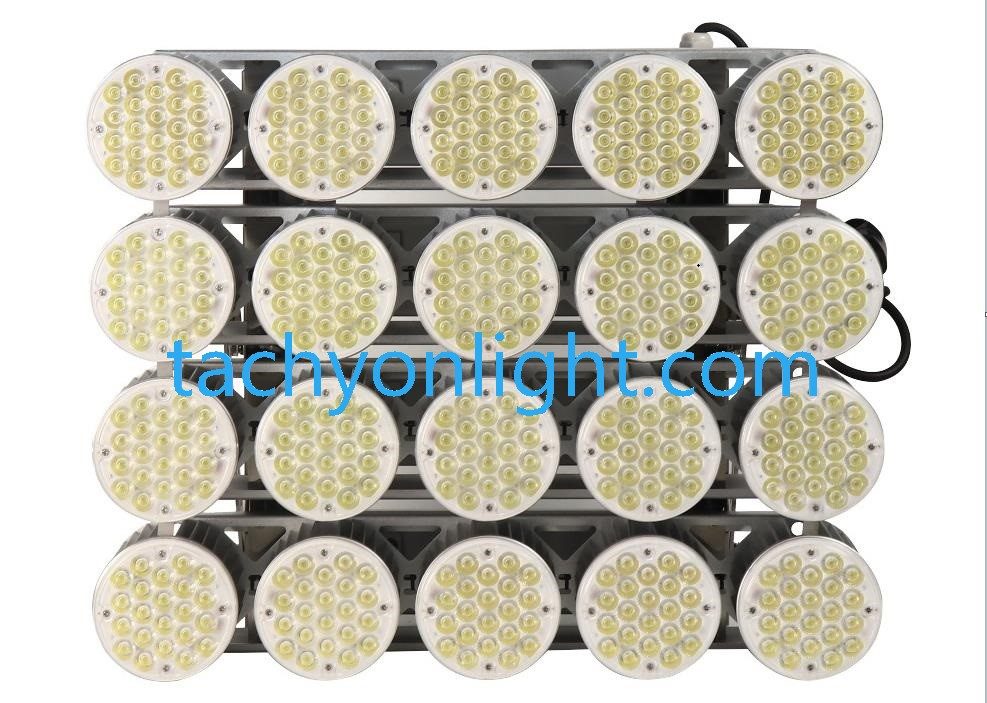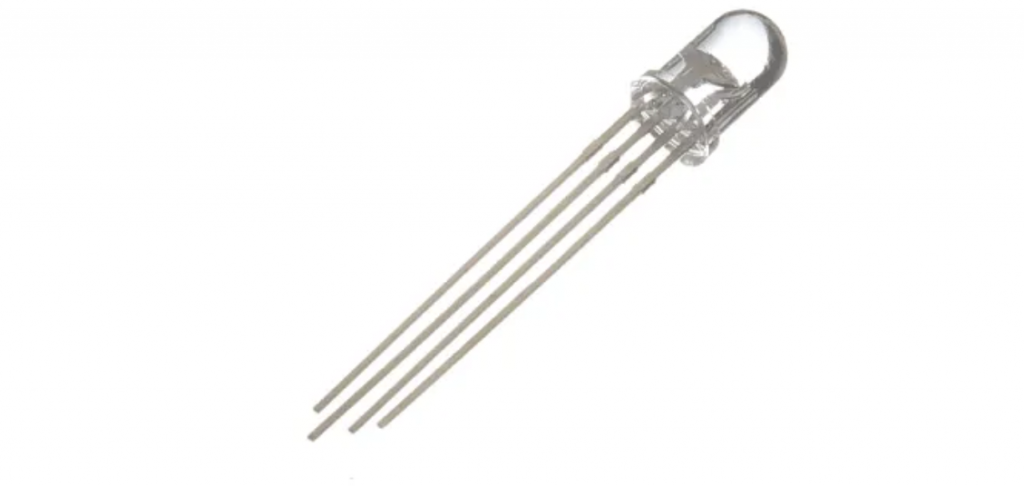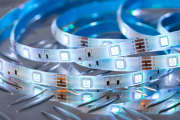What is LED
LED is the abbreviation of English light emitting diode (light emitting diode), its basic structure is a piece of electroluminescent semiconductor material, placed on a leaded shelf, and then sealed with epoxy resin around, plus a suitable voltage, it glows normally.
Some Common Sense of LED Beads
Common sense of LED chip size
According to the appearance classification, the chip is generally divided into round and square. Among them, the wafer is relatively low-end and the performance is not stable enough. I generally do not use the LED produced by the wafer. The square wafer is generally measured by size, such as 12mil (1mil = 0.0254 square millimeter). Generally speaking, for chips of the same brand, the larger the chip size, the higher the brightness. The LED lamp beads I use most often, red light and yellow light are generally 9~12mil, white, blue, and green light are generally 12~14mil. This is also the most commonly used chip on the market. If you use a larger chip, the brightness Although it can be improved a lot, the price of the chip has increased significantly, which is why few people adopt large-size chips.
Common sense of LED color
the general wavelength of the red light chip is 620~630nm (nanometer), the general wavelength of the green light chip is 527nm, the general wavelength of the blue light chip is 470nm, and the general wavelength of the yellow light chip. The wavelength is 585nm, and the white light LED also uses a blue chip. Just add a proper amount of phosphor to the blue chip to emit white light.
LED classification
Divided by power: it can be divided into low power and high power (in the industry, lamps above 0.5W are generally called high-power lamps).
According to the shape: it can be divided into in-line type and patch type.
Straw hat LED: according to the size of the lamp cap, it can be subdivided into F3 (the diameter of the lamp is 3mm), F5 (the diameter of the lamp is 5mm); or according to the shape of the lamp, it can be subdivided into endless, thin, thick, and round; Whether the lamp holder is transparent or not can be divided into transparent and foggy.
Piranha LED: It can also be divided into F3 and F5 according to the size of the lamp holder. According to the shape of the lamp holder, it is divided into round head (that is, the most common piranha lamp), flat head (this kind of head is very special, and its light-emitting angle is close to 180 degrees. Generally used in occasions that require astigmatism).
Low-power SMD LED: According to the size, it can be divided into 0805, 1206, 3020, 3528, 5050 or 5060 (the difference between 5050 and 5060 is very small, and it is difficult to distinguish with the naked eye, and customers who are not professional can call it according to his habits).
High-power LED: generally distinguished by power, common ones are 0.5W, 1W, 3W, 5W, 8W, etc.
Common sense of the number of LED chips
The most common use of the same LED lamp is to use only one chip, but under special circumstances, two or even four chips can be used. For example, one straw hat lamp can use one to two chips (considering its small size and poor heat dissipation) Convenience leads to unstable performance, generally only one or two chips are used); a piranha lamp can use one, two, three, four chips, the most commonly used are one and two chips; SMD 3528 lamps can use one , Two, three chips (one or two chips are commonly used in our company), SMD 5050/5060 generally uses three chips. Special note: There are two situations when the SMD lamp uses three chips:
- The colors of the three chips are exactly the same
2. The three chips are red, green and blue, which are what we often call RGB lights.
Common sense of LED viewing angle
The most common light-emitting angle of in-line LEDs is 120 degrees, and special ones can be 45 degrees, or 15 degrees.
LED voltage (voltage) common sense
A single low-power LED lamp, with different colors, requires different voltages. Red/yellow: generally 1.8~2.1 volts, white/green/blue: generally 3.0~3.6 volts. 1W high-power lamp requires the same voltage as above.
LED current (current) common sense
- For low-power LED lights (including plug-in or SMD), the current allowed on each chip is generally not higher than 20 mA; the current allowed on each dual-chip lamp is generally not higher than 40 mA; the same Do not manage each three-chip lamp higher than 60 mA.
- For high-power LEDs, I often use 1W, and the maximum allowable current is 150 mA.
Common sense of LED brightness (intensity)
- Definition of candlelight, international candlelight and candela
Under the standard atmospheric pressure of 101325 Newtons per square meter, an absolute “black body” (that is, an ideal object that can absorb all external light without reflection) with an area equal to 1/60 square centimeters, at the solidification temperature of pure platinum (Pt) (about 2042K) At 1769℃), the luminous intensity along the vertical direction is 1 candela. Moreover, the three concepts of candlelight, international candlelight and candela are different and should not be equal. In terms of quantity, 60 candela is equal to 58.8 international candles, and 1 candela of Hefner lamp is equal to 0.885 international candles or 0.919 candela.
- Luminous intensity and brightness
Luminous intensity is abbreviated as light intensity, and the international unit is candela (Candela) abbreviated cd. Lcd refers to the luminous flux emitted by the light source within the unit solid angle of the specified direction. When the light source radiation is uniform, the light intensity is I=F/Ω, Ω is the solid angle, the unit is steradian (sr), F is the luminous flux, the unit is lumens, and for point light sources, I=F/4. Luminance refers to the brightness of the light-emitting surface, which refers to the ratio of the luminous intensity of the light-emitting surface in a specified direction to the area of the light-emitting surface perpendicular to the specified direction, and the unit is candela/square meter.
For a diffuse scattering surface, although the light intensity and luminous flux in each direction are different, the brightness in each direction is equal. The fluorescent screen of the TV is similar to such a diffuse scattering surface, so the image from all directions has the same sense of brightness.
3.mcd value
Mcd value is an irregular name in the industry. Because of the different test instruments of different manufacturers, the measured mcd value of the same product is not the same. In the actual sales process, the two most commonly encountered concepts are lumen and brightness (mcd) values. As a salesperson, you don’t need to fully understand technically, but you need to keep in mind the mcd value of our conventional low-power LED lights.
Common sense of LED color temperature
Color temperature is the most general indicator of the spectral quality of a light source. The color temperature is defined by the absolute black body. When the radiation of the light source in the visible region is exactly the same as that of the absolute black body, the temperature of the black body at this time is called the color temperature of the light source. The characteristic of low color temperature light sources is that in the energy distribution, red radiation is relatively more, usually called “warm light”; after the color temperature increases, the proportion of blue radiation in the energy distribution increases, usually called “cold light”.
The color temperature of some commonly used light sources is: standard candlelight is 1930K (Kelvin temperature unit); tungsten lamp is 2760-2900K; fluorescent lamp is 3000K; flash lamp is 3800K; noon sunlight is 5400K; electronic flash is 6000K; blue sky is 12000-18000K. General definition, warm white temperature: 2700-3200K, normal white: 4000-4500K, daylight white: 6000-6500K, cool white: above 6500K.
the Advantages of LED Light Sources
As a light-emitting device, LED has attracted people’s attention because of its advantages over other light-emitting devices. In summary, LED has the following advantages:
(1) Long working life: LED, as a solid-state light-emitting device with conductor, has a longer working life than other light emitters. Its brightness half-life can usually reach 100,000 hours. If the LED is used to replace the traditional car lamp, its life will be much longer than the life of the car body, and it will not need to be repaired and replaced for life.
(2) Low power consumption: LED is a low-voltage working device, so under the same brightness, power consumption is minimal, which can greatly reduce energy consumption. On the contrary, with the future development of technology and materials, it will have higher luminous efficiency. People have calculated that if all the lighting fixtures in Japan are replaced by LEDs, two large power plants can be reduced, which is very beneficial to environmental protection.
(3) Fast response time: LED can generally respond within tens of milliseconds (ns), so it is a kind of telling device, which is beyond the reach of other light sources. The use of LEDs to make high-position brake lights for automobiles greatly improves the safety of automobiles at high speeds.
(4) Small size, light weight, and anti-attack: This is the inherent characteristic of semiconductor solid-state devices. Color LED can produce all kinds of clear and delicate display devices.
(5) Easy dimming, color adjustment, and great controllability: As a light-emitting device, LED can control brightness by changing the current flowing, and can also realize color change and adjustment through the configuration of different wavelength LEDs. Therefore, the light source or display screen composed of LED is easy to meet the needs of various applications through electronic control, and compatibility with IC computers is extremely difficult. In addition, the application of the LED light source is not restricted by scenting in principle, and it is highly plastic and can be extended arbitrarily to achieve building block assembly. The current large-screen color display is none other than LED.
(6) The light source made of LED has no environmental pollutants such as mercury and lead, and will not pollute the environment. Therefore, people are well-deserved to call LED light sources “green” light sources.
Which type of LED Bead is the Brightest
LED lights are now widely used in various occupations, such as store billboards, some store decorations, and decorative light strips for cars. For those of you who don’t understand LED lights, there are doubts about which type of LED lamp bead has higher brightness and which is better. So today, we will briefly introduce the various types of lamp beads.
LED lamp bead type brightness ranking:
- LED3528 lamp beads (9X26) chip, light efficiency: 130lm/W.
- LED3528 lamp beads (10X26) chip, light efficiency: 140lm/W.
- LED3528 lamp beads (10X23) chip, luminous efficiency: 140lm/W. (Sanan chip)
- LED3528 lamp beads (10X30) chip, light efficiency: 150lm/W.
The above are the brightest LED lamp bead types on the market, and they are also the most suitable lamp bead types for light strips or billboards.
The brightest LED bead type
- In-line lamp bead type: The common in-line lamp is straw hat lamp, round head, flat head, and the lamp body size is divided into: F3F5F8F10, etc., which is also a relatively simple type found in the market.
Secondly, the type of SMD lamp beads:
The common SMD lamps are 0603.1206.0805.020.3528.2835.5050.5630.5730 and so on. This type of lamp bead is good in terms of brightness or heat generation.
Thirdly, the type of high-power lamp beads: high-power refers to the power above 0.5W, such as 1W, 3W, 5W, 10W, 20W, 50W, 100W, etc., this type of lamp bead type is relatively simple to heat, but the brightness of the lamp is still A good type.




